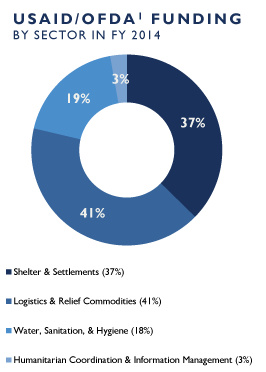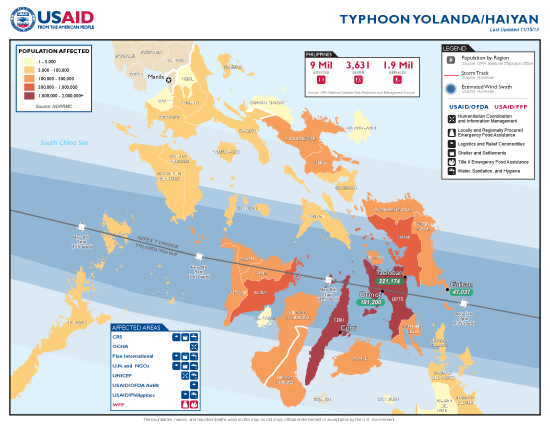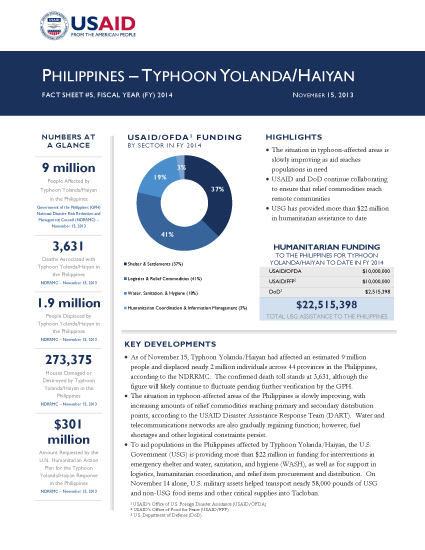- What We Do
- Agriculture and Food Security
- Democracy, Human Rights and Governance
- Economic Growth and Trade
- Education
- Ending Extreme Poverty
- Environment and Global Climate Change
- Gender Equality and Women's Empowerment
- Global Health
- Water and Sanitation
- Working in Crises and Conflict
- Disaster Assistance
- Political Transition Initiatives
- Conflict Mitigation and Prevention
- Countering Violent Extremism
- Disaster Risk Reduction
- Peacebuilding and Reconciliation
- Providing Safe & Secure Environments for Development
- Recovering From Crisis
- Resilience
- Tech Challenge for Atrocity Prevention
- World Humanitarian Day
- U.S. Global Development Lab
November 15, 2013
Highlights
Numbers At A Glance
9 million
3,631
1.9 million
273,375
$301 million
Humanitarian Funding:
To The Philippines For Typhoon Haiyan/Yolanda To Date In FY2014:

| USAID/OFDA | $10,000,000 |
| USAID/FFP | $10,000,000 |
| DoD | $2,515,398 |
| TOTAL | $22,515,398 |
Typhoon Haiyan / Yolanda Fact Sheet #5 - 11/15/2013 ![]() (pdf - 213k)
(pdf - 213k)
The situation in typhoon-affected areas is slowly improving as aid reaches populations in need
USAID and DoD continue collaborating to ensure that relief commodities reach remote communities
USG has provided more than $22 million in humanitarian assistance to date
Key Developments
As of November 15, Typhoon Yolanda/Haiyan had affected an estimated 9 million people and displaced nearly 2 million individuals across 44 provinces in the Philippines, according to the NDRRMC. The confirmed death toll stands at 3,631, although the figure will likely continue to fluctuate pending further verification by the GPH.
The situation in typhoon-affected areas of the Philippines is slowly improving, with increasing amounts of relief commodities reaching primary and secondary distribution points, according to the USAID Disaster Assistance Response Team (DART). Water and telecommunications networks are also gradually regaining function; however, fuel shortages and other logistical constraints persist.
To aid populations in the Philippines affected by Typhoon Yolanda/Haiyan, the U.S. Government (USG) is providing more than $22 million in funding for interventions in emergency shelter and water, sanitation, and hygiene (WASH), as well as for support in logistics, humanitarian coordination, and relief item procurement and distribution. On November 14 alone, U.S. military assets helped transport nearly 58,000 pounds of USG and non-USG food items and other critical supplies into Tacloban.
WASH
- On November 15, the U.N. reported that Tacloban city’s municipal water system is operational, with 28,000 water connections recently restored in 8 municipalities. The system is functioning at 30 percent capacity and providing water to an estimated 150,000 people.
- While the Tacloban water system is capable of producing sufficient quantities of safe drinking water to meet the needs of city residents, the system has not yet resumed full operation due to fuel shortages. Relief agencies and the GPH are working to procure the necessary fuel, and DoD plans to provide additional fuel in the short term until the international community organizes additional suppliers.
- USAID/OFDA is providing the U.N. Children’s Fund (UNICEF), one of the lead agencies for the WASH Cluster, with $750,000 to procure a generator to help restore power to Tacloban’s municipal water system. To date, USAID/OFDA has provided approximately $1.6 million for WASH activities in storm-affected areas.
LOGISTICS AND RELIEF COMMODITIES
- The USAID DART reports that significant quantities of humanitarian goods are reaching primary and secondary distribution points despite logistical constraints. The GPH, the U.N. World Food Program (WFP), and other relief agencies are mobilizing additional trucks, aircraft, and boats to transport relief commodities and personnel. WFP has mobilized at least 16 trucks, which are currently transporting 320 metric tons (MT) of rice to Tacloban, as well as a barge that is transporting approximately 2,000 MT of food and other relief commodities provided by WFP, other U.N. agencies, and USAID/FFP.
- WFP has also contracted a large cargo vessel capable of transporting more than 5,000 MT of cargo, which is set to arrive in Cebu on November 18. With the recent reopening of the port in Tacloban, ships can begin to deliver food and relief commodities directly to the city, alleviating pressure placed on the city’s airport and the region’s air transportation network. The Logistics Cluster—the coordinating body for humanitarian logistics activities in the Philippines—reports that a dedicated fleet of trucks is being mobilized to operate in Leyte Province to boost the capacity for aid deliveries.
- DoD continues to airlift USAID, WFP, and GPH food, emergency relief commodities, and humanitarian personnel from Manila to Tacloban. On November 14, U.S. military assets transported approximately 2,350 pounds of USAID/OFDA emergency relief supplies, 5,200 pounds of WFP high-energy biscuits, and 50,260 pounds of GPH food commodities to Tacloban. On November 15, the DoD transported 45 humanitarian personnel to typhoon-affected areas.
- To date, USAID/OFDA has provided approximately $3.5 million for logistics support and the provision of relief commodities, representing more than 40 percent of USAID/OFDA funding to date. In addition, DoD has contributed more than $2.5 million, primarily for airlifts and other logistical support.
FOOD SECURITY
- As of November 15, Typhoon Yolanda/Haiyan had destroyed approximately 384,000 acres of land planted with rice, corn, and other crops, resulting in the loss of nearly 237,000 MT of food crops, according to the NDRRMC. The latest U.N. situation report noted a priority need to provide rice seeds and agricultural inputs to approximately 250,000 farmers by mid-December to allow them to replant lost crops during the rest of the country’s annual rainy season.
- Increasing quantities of food distributions are reaching populations in need. By November 15, GPH Department of Social Welfare and Development (DSWD) family food packs—which include rice rations provided by WFP with USAID/FFP support—had reached more than 170,000 people. The food packs contain canned goods and more than 6 pounds of rice and are sufficient to feed a family of five for up to three days. In addition, WFP distributed packets of high-energy biscuits to 5,000 people awaiting evacuation at Tacloban airport on November 14. Distributions of the biscuits—procured by WFP with USAID/FFP funding—are ongoing in Guiuan and Tacloban. To date, USAID/FFP has committed $10 million toward WFP's response in the Philippines.
HEALTH
- On November 15, the GPH Department of Foreign Affairs requested that relief partners suspend the arrival of additional foreign medical teams until further notice. At least 16 foreign teams are already en route to the Philippines or in Manila awaiting deployment, according to the U.N.
- The GPH Department of Health (DoH) is leading the Health Cluster—the coordinating body for health-related humanitarian activities in the Philippines—with the support of the U.N. World Health Organization (WHO) and has deployed 300 additional personnel to affected areas and set up command posts in Tacloban and Manila.
- According to WHO, post-typhoon health priorities include injury management, preventing the spread of communicable disease, and provision of maternal and child health services, as well as psychosocial support. DSWD estimates that nearly 208,000 pregnant women and more than 138,000 lactating women—some of whom are living in evacuation centers—were affected by the typhoon and may require assistance in the coming days and weeks.
OTHER HUMANITARIAN ASSISTANCE
- As of November 15, international donors had pledged nearly $160 million to address humanitarian needs among populations affected by Typhoon Yolanda/Haiyan. The total amount pledged represents approximately 53 percent of the $301 million requested by the U.N. Humanitarian Action Plan for the Philippines typhoon response.
- European Commissioner for International Cooperation, Humanitarian Aid and Crisis Response Kristalina Georgieva arrived in the Philippines on November 15 to meet with national and local GPH officials, as well as U.N. and other relief agency staff, and to assess the humanitarian situation in typhoon-affected areas. To date, the European Commission’s Directorate-General for Humanitarian Aid and Civil Protection (ECHO) has announced a first tranche of nearly $4 million in humanitarian assistance and has pledged approximately $13 million for reconstruction efforts.
- On November 15, the Government of Japan (GoJ) announced plans to extend an additional $20 million in funding for emergency response activities in the Philippines. This most recent contribution brings the total GoJ-provided assistance to approximately $52 million, including $600,000 of emergency relief items, $20 million provided through the Japan Fund for Poverty Reduction of the Asian Development Bank, and $1.5 million donated through Japan Platform, a Japanese non-governmental consortium.









Comment
Make a general inquiry or suggest an improvement.